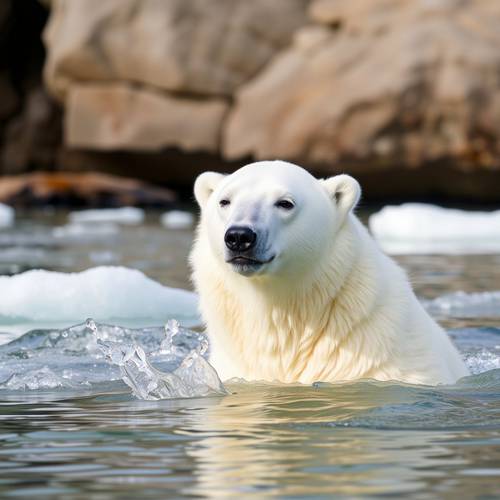How Fast Can Polar Bears Run? An Introduction
Polar bears (Ursus maritimus) are the undisputed apex predators of the Arctic, uniquely built for a life surrounded by ice, snow, and freezing waters. Known for their incredible strength and stealthy hunting skills, they often appear slow and lumbering due to their sheer size. But that leads many to wonder: how fast can polar bears run? Despite their bulky appearance, polar bears are capable of surprisingly fast sprints when they need to. In this article, we’ll explore just how quick they really are, what affects their speed, and how they compare to other animals in the wild.
Understanding their land speed is essential to fully appreciate their adaptations as versatile Arctic hunters.
Top Running Speed: Quick Bursts on Ice
So, just how fast can a polar bear run? Over short distances, polar bears can reach impressive speeds. Most sources, including Polar Bears International, state that they can run at speeds of up to 40 kilometers per hour (about 25 miles per hour). This is considerably faster than a human sprinter and showcases their powerful musculature.
However, it's important to note that this speed is typically maintained only for very short bursts. Polar bears are not built for sustained high-speed chases like cheetahs or wolves. Their primary hunting strategy involves stealth, ambush, and patience, often waiting near seal breathing holes or stalking prey across the ice. The ability to run fast is more for a quick charge during an ambush or for traversing difficult terrain rapidly.

Factors Influencing a Polar Bear's Running Speed
Several factors can influence how fast an individual polar bear can run:
Age and Health: Young, healthy adult polar bears in their prime are likely to be the fastest. Older bears, or those in poor health, may not achieve top speeds.
Terrain: Polar bears are adept at moving over snow and ice. Their speed might be slightly different on solid ground versus broken sea ice or deep snow. Their adaptations generally favor icy conditions.
Motivation: A polar bear chasing prey or fleeing a perceived threat will likely exert maximum effort and achieve its top speed. Casual movement will be much slower.
Body Mass and Overheating: Polar bears have a thick layer of blubber and dense fur for insulation in extreme cold. While essential for survival, this can cause them to overheat quickly during strenuous activity like running. This is a primary reason why they don't sustain high speeds for long periods.
Built for the Arctic: Adaptations for Movement
Polar bears possess several physical adaptations that aid their movement, including running, on the challenging Arctic terrain:
- Large Paws: Their paws are broad and can be up to 30 cm (12 inches) across, acting like snowshoes to distribute their weight and prevent them from sinking into soft snow.
- Rough Paw Pads (Papillae): The soles of their feet are covered with small, soft bumps called papillae, which provide excellent traction on slippery ice.
- Non-Retractile Claws: Their short, stocky, and non-retractile claws dig into snow and ice, further enhancing their grip.
- Powerful Musculature: Despite their bulk, they have strong limbs capable of propelling their large bodies forward with considerable force.
These features contribute to their surprising agility for such large animals and are key to understanding how fast polar bears can run in their specialized environment.
How Fast Can Polar Bears Run Compared to Other Animals?
To put their speed into perspective, here's a comparison of the approximate top running speeds of polar bears and some other animals:
| Animal | Approximate Top Speed (km/h) | Approximate Top Speed (mph) | Primary Terrain/Notes |
|---|---|---|---|
| Polar Bear | 40 | 25 | Ice, Snow (Short bursts) |
| Grizzly Bear | 56 | 35 | Land (Short bursts) |
| Arctic Fox | 50 | 30 | Snow, Tundra |
| Caribou (Reindeer) | 80 | 50 | Tundra, Snow |
| Wolf | 65-70 | 40-43 | Varied (Can sustain for longer) |
| Human (Usain Bolt peak) | 44.7 | 27.8 | Track |
| Seal (on land) | ~3-5 | ~2-3 | Ice, Land (awkward) |
This table shows that while polar bears are not the fastest runners in the animal kingdom, or even among bears, their speed is significant, especially considering their size and the challenging terrain they navigate. As National Geographic often highlights, their adaptations are a suite of tools for Arctic survival.
Masters of Two Realms: Running vs. Swimming Speed
While their land speed is noteworthy, polar bears are also exceptionally powerful swimmers. They are far more adapted to aquatic life than other bear species. If you're curious about their abilities in the water, you can learn more about how fast a polar bear can swim. Their proficiency in both running and swimming makes them versatile hunters in the dynamic Arctic environment.
Frequently Asked Questions
Can a human outrun a polar bear?
No. Polar bears can run up to 40 km/h (25 mph), which is faster than most humans. Trying to outrun one would not be a safe option.
How long can polar bears run at full speed?
Only for short bursts. Due to their size and thick insulation, they can overheat quickly and are not built for endurance running.
Do polar bears prefer to chase prey?
No. They rely more on stealth and patience, such as waiting near seal breathing holes, rather than chasing prey over long distances.
Conclusion: Arctic Agility and Power
Polar bears aren’t just powerful swimmers — they’re also capable of surprising bursts of speed on land. This ability, combined with their strength and stealth, makes them perfectly suited for survival in one of the planet’s harshest environments. As Arctic conditions continue to change, understanding and protecting these remarkable predators becomes more important than ever.